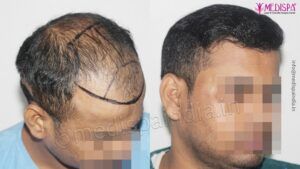
Hair transplant surgery has become one of the most frequently discussed cosmetic surgical procedures, primarily due to increasing aesthetic concerns. The predominant issue remains hair loss, which significantly impacts both social and professional quality of life. While genetics is often the primary factor contributing to hair loss in the Indian demographic, various other elements can also play a role. These include practices such as wet combing, chemical straightening, the use of heated styling tools, inadequate nutrition, as well as lifestyle factors like alcohol consumption, smoking, and certain medications, including antidepressants, anti-anxiety drugs, and antipsychotics.
In light of these concerns, individuals are increasingly seeking methods to prevent or mitigate hair loss. Numerous blogs provide information on medications, herbal remedies, and other treatments; however, it is unfortunate that no solution can effectively halt hair loss associated with pattern baldness. The only reliable approach to restore hair is through hair transplantation or hair restoration procedures.
When contemplating a hair transplant, many individuals express concern about the longevity of the results. Will the transplanted hair endure indefinitely, or will additional procedures be necessary in the future? The reassuring news is that a hair transplant performed by experienced and qualified professionals is likely to be permanent.
Hair follicles in the frontal and vertex areas are particularly vulnerable to damage due to their androgen sensitivity, which is why they are often affected by hair loss. In contrast, the occipital region is considered a safe donor site for grafting, as it does not possess these androgen-sensitive receptors.
Hair transplant procedure
Hair transplantation is a cosmetic procedure that is minimally invasive and relatively straightforward. Many individuals experiencing hair loss choose this surgical option, which effectively addresses hair loss on both the scalp and face. The process involves extracting hair follicles from a donor site and transplanting them into areas of baldness.
A single hair transplant session can lead to the development of healthy hair; however, those with significant baldness may need to undergo multiple sessions. The length of the procedure typically varies from 4 to 9 hours in one visit, depending on the severity of baldness and the specific hair transplant technique employed.
There are two primary techniques utilized in hair transplantation: Follicular Unit Extraction (FUE) and Follicular Unit Transplantation (FUT). The methods for harvesting hair follicles differ between these two approaches. Given the procedure’s relative simplicity, the recovery period is generally brief, with complete healing usually occurring within 7 to 10 days.
Methods for hair transplantation
The pivotal phase in hair transplant surgery is the harvesting of grafts, which can be executed through two primary techniques:
- FUT (Follicular Unit Transplantation), commonly referred to as the strip procedure, entails excising a strip from the donor area of the scalp. This strip is subsequently dissected to extract individual grafts, which are then meticulously implanted into the balding regions of the recipient, with careful consideration given to the orientation, arrangement, and alignment of the grafts.
- FUE (Follicular Unit Extraction) hair transplant: This technique involves the extraction of each individual hair follicle directly from the donor area of the scalp, followed by their implantation into the recipient’s bald spots.
The selection of these methods is based on their respective benefits and drawbacks, while also taking into account factors such as Norwood’s classification of hair loss, the age and sex of the patient, and the hair density in the donor region. It is essential for the surgeon to make a well-informed decision regarding the procedure that best serves the interests of the patients.
Does hair transplant deliver permanent results?
The widespread popularity of this procedure can be attributed to its capacity to provide lasting, permanent results. Hair follicles in the frontal and vertex areas are particularly susceptible to DHT, which causes them to thin or miniaturize, resulting in hair loss. Conversely, the hair follicles located in the occipital region (the back and sides of the head) exhibit resistance to DHT and remain unaffected by hormonal fluctuations, thus preventing hair loss. The genetic traits of these follicles are inherent to the follicles themselves rather than the scalp, enabling their relocation to any area while maintaining viability for a lifetime.
Although this procedure offers enduring outcomes, it does not halt the progressive loss of existing natural hair. Therefore, since hair loss is a continuous condition, it may persist even after a hair transplant; however, it is highly improbable that the transplanted hairs will be impacted.
Dr. Suneet Soni, a distinguished hair transplant surgeon in India with an MCh in Plastic Surgery, is celebrated for his outstanding hair transplant results. He is recognized as one of the foremost specialists in hair transplant in Delhi. His surgical proficiency, coupled with a refined aesthetic sense, enables him to achieve results that are both long-lasting and natural in appearance. Dr. Soni has been honored at numerous national and international conferences for his significant contributions to the field of hair transplantation and his research efforts. Medispa Hair Transplant Clinic is not only one of the most reputable centers but also provides competitive pricing for hair transplant cost in Delhi.
Is it possible that you could need another hair transplant?
The hair transplant procedure has experienced remarkable progress, with contemporary techniques facilitating results that were once considered impossible. It is now feasible to attain high-density hair growth in a single session, significantly reducing the need for multiple transplant procedures. When executed by experienced professionals, the transplanted hair is expected to endure for a lifetime. Nonetheless, certain situations may require additional transplant sessions, such as:
- The advancement of hair loss coupled with the continuous shedding of existing hair.
- Severe and progressive hair loss that cannot be adequately managed in a single appointment.
- The unsuccessful outcome of the hair transplant due to the choice of an inadequately qualified clinic.
The key to a successful and enduring hair transplant lies in selecting the right clinic and a skilled surgeon. Book your appointment today at Medispa Hair Transplant Clinic to receive top-tier hair transplant services.




